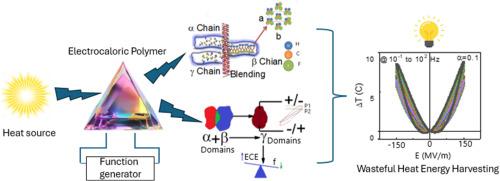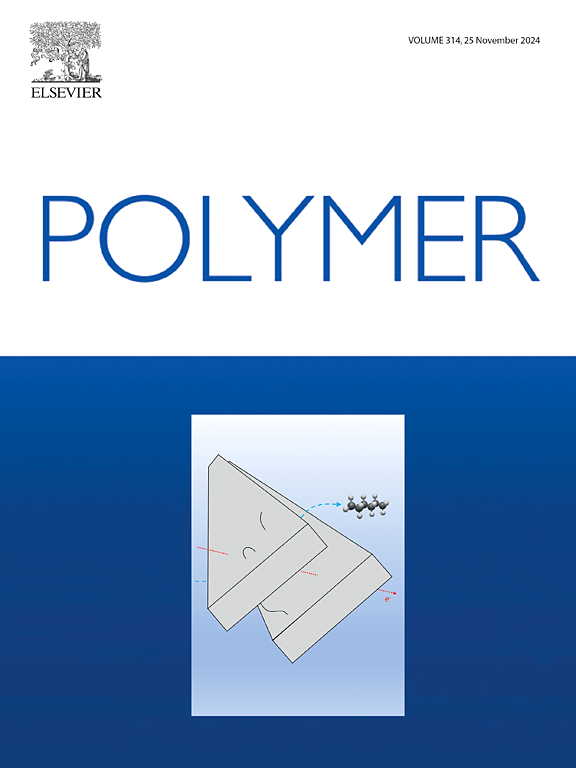Frequency-Dependent Ferroelectric Heat Cycles in Polymer Blends: Enhancements in Electrocaloric Performance of P(VDF-TrFE) and P(VDF-TrFE-CTFE)
IF 4.1
2区 化学
Q2 POLYMER SCIENCE
引用次数: 0
Abstract
Copolymer (P(VDF-TrFE-CTFE)) and terpolymer (P(VDF-TrFE)) have been widely investigated for their promising electrocaloric effect (ECE), whereas, their mixture of ECE has not been investigated. In this work, P(VDF-TrFE was mixed with a variety of concentrations of P(VDF-TrFE-CTFE) and its ECE effect was investigated in detail. Results indicated that after mixing of the copolymer, an additional change of adiabatic temperature (T+Tad) could be obtained. Moreover, the energy density (ND) is drastically enhanced when the copolymer concentration increases up to 3% due to antiferroelectric behavior of polymer blends ( i.e. Copolymer content = 30 wt%). In addition, we observed that we can tune the working of frequency dependent ferroelectric heat cycle instead of pyroelectric heat cycle by changing the operational frequency in antiferroelectric range and the rejection of output heat is increased by decreasing the operational frequency (from 10-2Hz to 102 Hz). And we propose to use ΔT Vs E loop as the criteria to explain the ferroelectric heat cycle. Using this novel technique, we could successfully compare the efficiency of heat cycles. Three times higher efficiency of ΔT-E loop at low frequency (10-2 Hz) was achieved due to the blend’s antiferroelectric behavior.

聚合物混合物中与频率相关的铁电热循环:P(VDF-TrFE) 和 P(VDF-TrFE-CTFE) 电致冷性能的提高
共聚物(P(VDF-TrFE-CTFE))和三元共聚物(P(VDF-TrFE))因其良好的电致发光效应(ECE)而受到广泛研究,但对它们的混合物的 ECE 尚未进行研究。本研究将 P(VDF-TrFE 与各种浓度的 P(VDF-TrFE-CTFE) 混合,详细研究了其 ECE 效应。结果表明,共聚物混合后,可获得额外的绝热温度(T+Tad)变化。此外,由于聚合物共混物的反铁电行为(即共聚物含量 = 30 wt%),当共聚物浓度增加到 3% 时,能量密度(ND)会急剧增加。此外,我们还观察到,通过改变反铁电范围内的工作频率,我们可以调整频率相关铁电热循环的工作方式,而不是热释电热循环。我们建议使用 ΔT Vs E 循环作为解释铁电热循环的标准。利用这项新技术,我们成功地比较了热循环的效率。由于混合物的反铁电行为,低频(10-2 Hz)下的 ΔT-E 循环效率提高了三倍。
本文章由计算机程序翻译,如有差异,请以英文原文为准。
求助全文
约1分钟内获得全文
求助全文
来源期刊

Polymer
化学-高分子科学
CiteScore
7.90
自引率
8.70%
发文量
959
审稿时长
32 days
期刊介绍:
Polymer is an interdisciplinary journal dedicated to publishing innovative and significant advances in Polymer Physics, Chemistry and Technology. We welcome submissions on polymer hybrids, nanocomposites, characterisation and self-assembly. Polymer also publishes work on the technological application of polymers in energy and optoelectronics.
The main scope is covered but not limited to the following core areas:
Polymer Materials
Nanocomposites and hybrid nanomaterials
Polymer blends, films, fibres, networks and porous materials
Physical Characterization
Characterisation, modelling and simulation* of molecular and materials properties in bulk, solution, and thin films
Polymer Engineering
Advanced multiscale processing methods
Polymer Synthesis, Modification and Self-assembly
Including designer polymer architectures, mechanisms and kinetics, and supramolecular polymerization
Technological Applications
Polymers for energy generation and storage
Polymer membranes for separation technology
Polymers for opto- and microelectronics.
 求助内容:
求助内容: 应助结果提醒方式:
应助结果提醒方式:


